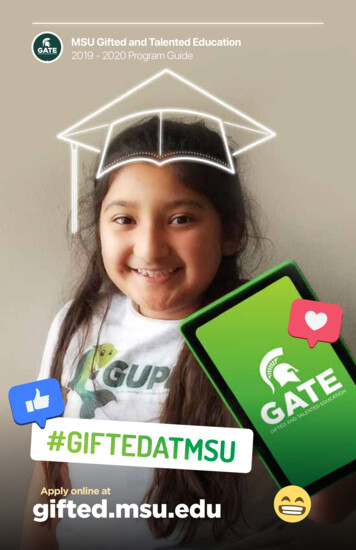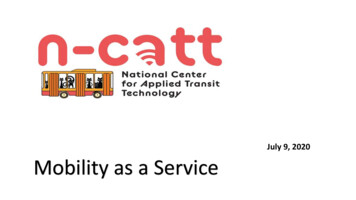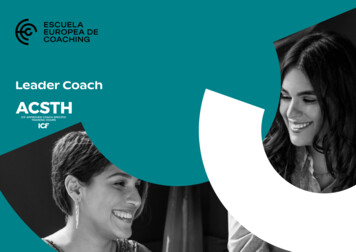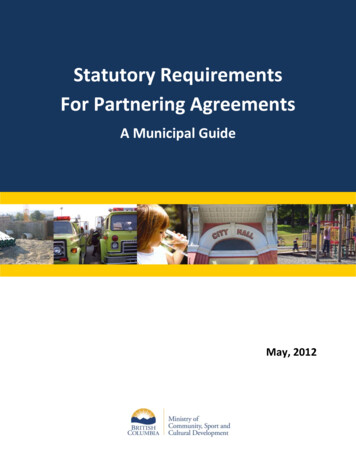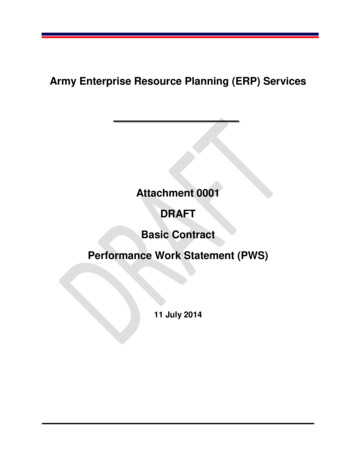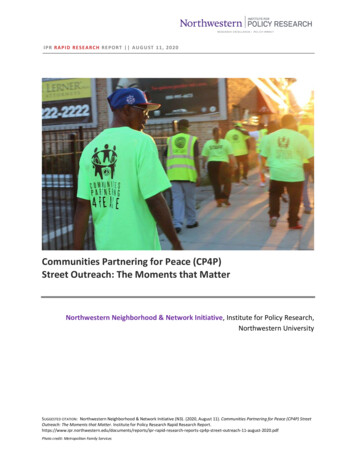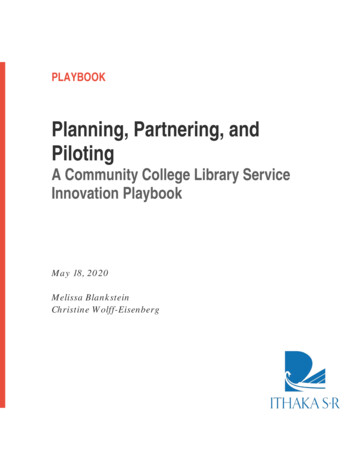
Transcription
PLAYBOOKPlanning, Partnering, andPilotingA Community College Library ServiceInnovation PlaybookMay 18, 2020Melissa BlanksteinChristine Wolff-Eisenberg
Ithaka S R provides research andstrategic guidance to help theacademic and cultural communitiesserve the public good and navigateeconomic, demographic, andtechnological change. Ithaka S R ispart of ITHAKA, a not-for-profitorganization that works to advanceand preserve knowledge and toimprove teaching and learningthrough the use of digitaltechnologies. Artstor, JSTOR, andPortico are also part of ITHAKA.Copyright 2020 ITHAKA. This work islicensed under a Creative CommonsAttribution 4.0 International License. To viewa copy of the license, please HAKA is interested in disseminating thisbrief as widely as possible. Please contactus with any questions about using the report:research@ithaka.org.This project was made possible in part by the Institute of Museum and Library Services RE-96-170113-17.The Institute of Museum and Library Services is the primary source of federal support for thenation's libraries and museums. We advance, support, and empower America’s museums,libraries, and related organizations through grantmaking, research, and policy development. Ourvision is a nation where museums and libraries work together to transform the lives of individualsand communities. To learn more, visit www.imls.gov and follow us on Facebook and Twitter.PLANNING, PARTNERING, AND PILOTING PLAYBOOK1
Service Concept TestingAs part of a multi-year student service innovation project, co-led by Northern VirginiaCommunity College and Ithaka S R, we developed and implemented a new mixedmethods assessment approach: service concept testing. 1 With participation from sixadditional community college partners and support from the Institute of Museum andLibrary Services, we designed, evaluated, and piloted a variety of service prototypes. Inthis playbook, we describe the services generated and piloted as a result of thesecollaborations and provide lessons for other institutions interested in developing andtesting new services in their context.Service concept testing is a mixed-methods market research process, guided by aparticipatory decision making framework, and entails gathering data on user needs,generating possible offerings, and testing those offerings. In our implementation of themethodology, we began with a qualitative discovery phase examining existing datasources and interviewing students. This was then followed by a service conceptdevelopment phase, which involved collaborative brainstorming for specific service ideasthat addressed the challenges and needs uncovered in the first phase. Lastly, we assessedthese concepts by surveying the student community to gauge the services’ potentialvalue. Representatives from each of the seven partner community colleges, referred to as“partner college” or “project lead” for the remainder of this playbook, held key roles ineach step of service concept testing. 2Students’ self-described goals and challenges, as well as experiential evidence from thepartner colleges, significantly guided our creation of eight “service concepts”—hypothetical prototypes of services that colleges might offer to students for specificpurposes relevant to the goals, challenges, and/or needs expressed by studentsthemselves. Based on the results from the assessment phase, the partner colleges wereFor more in-depth information on service concept testing, see Christine Wolff-Eisenberg and Roger Schonfeld, “What Do OurUsers Need? An Evidence-Based Approach for Designing New Services,” Ithaka S R, 6 November 2019,https://doi.org/10.18665/sr.312092.12 We would like to thank the project leads at the participating colleges: Jean Amaral, Borough of Manhattan Community College;Braddlee, Northern Virginia Community College; Christie Flynn; Pierce College District; Jeanne Galvin, Queensborough CommunityCollege; Katie Ghidiu, Monroe Community College; Michael Miller, Bronx Community College; and Steven Ovadia, LaGuardiaCommunity College.PLANNING, PARTNERING, AND PILOTING PLAYBOOK2
able to make data-informed judgements on services to implement at their library basedon both aggregate (cross-institutional) and local (institution-specific) results. 3QualitativediscoveryService conceptdevelopmentSurveyassessmentLearn about thepractices,preferences, andneeds ofcommunitycollege studentsand theirrelationship tosuccess by meansof on-campus,in-depth, inpersonqualitativeinterviewsDevelop a seriesof concepts forservices thatcommunitycolleges andtheir librariesmight seek tooffer based onthe discoveryphaseEvaluate theservice conceptswith communitycollege studentsby means of asurvey todetermine theirpotential valueToward generating this playbook, we held semi-structured interviews with project leadsin January 2020 following each college’s first semester or quarter of piloting a new oradapted service resulting from this project. In these interviews, we asked about thecolleges’ service development processes, implementation strategies, and outcomes. Wealso asked the project leads to share lessons learned from the pilot implementations andtheir recommendations for other institutions considering using a similar process todevelop services on their campuses. Although these services were implemented withinthe library, any unit on a college campus can utilize the service concept testingmethodology as well as the lessons learned from this piloting process. In this playbook,we synthesize and summarize both the services themselves as well as key takeaways fromthe process of implementing those services, offering strategic insights gleanedthroughout the initial implementation.Service Concepts in ActionPartner colleges often implemented one or two of the eight service concepts, selectingwhich services to employ based on a combination of (1) students’ valuation of the serviceconcept, (2) their colleges’ strategic initiatives, and (3) available resources. The followingFor more information on the aggregate results from the survey assessment phase, see Melissa Blankstein, Christine WolffEisenberg, and Braddlee, “Student Needs Are Academic Needs,” Ithaka S R, 30 September 2019,https://doi.org/10.18665/sr.311913.3PLANNING, PARTNERING, AND PILOTING PLAYBOOK3
section describes how the service concepts—which served as prototypes of services ratherthan services themselves—were translated into actual services. Some of the resultingservices derived from a single service concept are quite similar to one another, whilesome are very different, signaling the extent to which college strategic initiatives andavailable resources—along with mixed-methods research findings—drive the serviceimplementation process.Table 1. Partner colleges that piloted a service based on each conceptService ConceptsPartner CollegesLoaning TechQueensboroughCommunityCollegeNorthern VirginiaCommunityCollegePierce CollegeDistrictMonroeCommunityCollegePersonal LibrarianLaGuardiaCommunityCollegePierce CollegeDistrictBorough ofManhattanCommunityCollegeNorthern VirginiaCommunityCollegeChild CarePierce CollegeDistrictMonroeCommunityCollegeKnowledge BaseBronx CommunityCollegeLaGuardiaCommunityCollegeCommunity AdvocacyPierce CollegeDistrictLoaning Tech: access to technology, either to borrow for use outside of class andhome, or on-site with expert training and assistanceThrough our survey, we asked students how valuable they would find borrowing a varietyof technological resources, such as laptops, scientific calculators, Wi-Fi hotpots,black/white or color printers, and more. Overall, 42 percent of students across thepartner colleges rated this service as extremely valuable, and of those students, eight inten rated Wi-Fi hotspots, black/white or color printers, laptops, and multimedia editingcomputers or software as particularly useful to borrow or use. Roughly half of thepartner colleges were already loaning many of these specific resources prior to serviceconcept testing. Based on this new evidence they decided to adapt and expand theirexisting services:PLANNING, PARTNERING, AND PILOTING PLAYBOOK4
Queensborough Community College (QCC) extended the loaning period of laptops fromtwo-hour time slots to a week-long period. With the help of the Information Technology(IT) department and Vice President of Finance, the project lead was able to refurbish andrecycle laptops returned to IT by academic faculty—acquiring 24 laptops newly availableto loan. Northern Virginia Community College (NOVA) librarians collaborated with theirFinancial Stability Office to lend iPads with keyboards and wireless mice and laptops foran entire quarter to students with demonstrated need. Pierce College District (PCD) plans to expand their loaning tech service, which currentlyprovides Chromebooks, laptops, and hot spots for students to borrow. Additionalcomputers have been added to the quarterly loan program and alternative hot spotvendors are being considered. They are also providing information about low-costtechnology programs to students who apply for quarterly loans. Monroe Community College (MCC) is now seeking additional funding for more laptopsand other types of technological resources to loan.Personal Librarian: a professional employed by the college available to helpstudents find and use all kinds of content sources needed for coursework,including books and journals, in paper, and on the internetAcross the seven partner colleges, students rated this service concept as the third mostdesired, with about four in ten rating this service extremely valuable. Four partnercolleges decided to adapt this service: LaGuardia Community College (LAGCC) has academic subject librarian liaisons workingwith Academic Affairs and IT to provide specialized outreach and support, enablingstudents to contact their subject liaison with questions and requests via an onlineplatform, as well as allowing librarians to reach out to students. As LAGCC’s AcademicAffairs office stratifies students based on their support needs, the service is initiallytargeting students who need the lowest level of support. PCD identified an opportunity for integrating a personal librarian service into specificgeneral education English course tracks where there was a completion gap between thefirst two levels of the course. They are currently planning how to best scaffold informationcompetency instruction alongside personal contact points. Borough of Manhattan Community College (BMCC) also has librarian liaisons performingspecialized outreach and support to students, collaborating with Student Affairs toprovide this service to male students who fall below a certain threshold on their highschool records. NOVA identified two groups to target this service: students within the honors programand those within a specialized transfer program. Librarians provide researchconsultations and on-the-ground support within classes to honors students as well asPLANNING, PARTNERING, AND PILOTING PLAYBOOK5
similar support services outside of the classroom for students within the specializedtransfer program.Child Care: an array of services at a college for parents or caregivers ofchildren while they are attending class, which might include designated spacesfor families to study together, both regular and emergency childcare programs,and tutoring and other afterschool services for childrenAbout half of student parents or caregivers across the seven partner colleges rated childcare services as extremely valuable. Two partner colleges are piloting related services: PCD created child activity kits for children of different ages, filled with games, toys, andeducational books at different reading levels to occupy children with as their parent orcaregiver studies.Children activity bags, Pierce College District. Photo by Kathryn Scott MCC dedicated spaces at each campus library for family-friendly study rooms. Theserooms were remodeled with new, brightly colored and comfortable furniture, desks, andeducational toys and books for children. The college is also collaborating with their localYMCA to provide free drop-in childcare this semester.PLANNING, PARTNERING, AND PILOTING PLAYBOOK6
Family- Friendly Study Room, Monroe Community College Brighton Campus, LeRoy V Good LibraryKnowledge Base: a single point of contact for whenever a student needs helpnavigating any part of college including advising, registering for classes,applying for financial aid, securing personal counseling, and obtaining tutoringor other coursework assistance—offering expertise in connecting students withthe right college employee for assistanceKnowledge base was the most highly valued service concept, with 44 percent of studentsrating this service as extremely valuable. Despite the popularity of this service amongrespondents, getting this service off the ground requires substantial startup resources,including funding, time, and staffing. As a result, just two colleges are currently pilotinga knowledge base service: Bronx Community College (BCC) hired a non-teaching adjunct to collect data queriesreceived at their information desks to improve the training of relevant personnel as wellas their directory of campus and community services. 4 They are aiming to collaboratewith other service providers on campus to further streamline their knowledge baseservice as it continues.Because the IMLS grant for the service innovation project aided with personnel costs, some colleges were able to hire additionalstaff to help execute their pilot services.4PLANNING, PARTNERING, AND PILOTING PLAYBOOK7
Prior to this initiative, LAGCC already had a robust, online knowledge base, branded asAsk LaGuardia, monitored and managed by a librarian. 5 Ask LaGuardia providesprewritten answers to common questions students ask—such as how to change majors,how to set up an advising appointment, how to register for classes, etc. For their newpilot, LAGCC invested in promoting Ask LaGuardia to new students.Screenshot of AskLaGuardia, an existing knowledge base serviceCommunity Advocacy: an opportunity to help students better develop theircapacity as a member of their community and society through one-timepresentations, workshops, ongoing discussion groups, informal meetups oronline resources by faculty, members of community groups, industry experts, orfellow studentsAlthough only two in ten students across the partner colleges rated community advocacyas extremely valuable, one college decided to pilot this service: 5PCD implemented scheduled conversations and panel discussions on the pressingchallenges students face, including food insecurity, on the last Wednesday of everymonth, open to students, faculty, and other individuals in the community.For more information on this existing service, see: https://laguardia.intelliresponse.com/.PLANNING, PARTNERING, AND PILOTING PLAYBOOK8
Community advocacy panelists on food insecurity, Pierce College District. Photo by Elissa BlankenshipStrategic InsightsThe pilot services outlined above are very much tied to the strategic priorities of thepartner colleges, with varying levels of coordination and support from leadership andpeer colleagues. Lack of time, funding, and human resources, as well as difficulties withstudent outreach efforts, presented challenges to the project leads who neverthelessfound unique ways to utilize existing relationships and resources to execute their pilots.In the following section, we offer a series of high-level strategic insights from theexperiences of and reflections from the project leads.Align service implementation with strategic initiatives and existingservice modelsGrounding service conceptualization, development, and implementation withinstrategic initiatives and existing service models can be an effective way to gainapproval from leadership and help meet user needs.Naturally, project leads incorporated the strategic initiatives of their college as well asexisting service models provided by their own library, college, or other institutions wheninitially brainstorming the list of service concepts for subsequent testing via survey.Grounding services within their colleges’ strategic initiatives made it so that none of theservices were provided—or even tested—arbitrarily. Additionally, mapping services toexisting models either at their own college or at another institution provided afoundation to reinvent services and continuously meet user needs.PLANNING, PARTNERING, AND PILOTING PLAYBOOK9
Approximately half of the project leads chose to implement service concepts that mostaligned with the strategic initiatives of their college, even if students did not rate thoseservice concepts most valuable. For two project leads, aligning with their college’sstrategic priorities made it easier to get leadership approval and assistance. Additionally,four of the partner colleges already had been loaning laptops and other devices tostudents, but were able to expand and adapt this existing service based on new evidence,keeping their existing service sustainable.Provide meaningful engagement opportunities for faculty and staffearly on in service developmentIncorporating faculty and staff perspectives into service development can helpsecure their support and streamline the provision of new services duringimplementation.Some partner colleges experienced resistance to implementing new services from theirlibrary faculty and staff, who expressed concerns about potentially winding down otherservices traditionally offered by the library in favor of new services. Faculty and staffwere also worried about their own capacity and the amount of work adding new serviceswould entail. Generating early awareness of service development and subsequent plansfor implementation can potentially lead to useful conversations with faculty and staff toaddress their concerns prior to piloting.Project leads whose library faculty and staff were able to provide input earlier in theprocess often had a relatively easier time implementing their pilot(s). Since it will fall tothese individuals to provide new services to students, soliciting meaningful engagementhelps to secure their approval and streamline implementation. For instance, one collegethat piloted a version of the personal librarian service concept was able to target theirservice towards ameliorating completion gaps within their general education coursesbecause early on a librarian began researching external examples of the librarian liaisonmodel and opportunities to target completion gaps in tandem with the assessment phaseof the project. Through this librarian’s enthusiasm and research, this college was able totarget specific courses when they piloted this new service.PLANNING, PARTNERING, AND PILOTING PLAYBOOK10
Use multiple data sources as leverage—even if some aren’t specific toyour collegeBuild your case over time for providing new services using multiple empiricaland experiential data sources available internally or externally.It is important to know students both anecdotally and by generating and examiningempirical data. Through student interviews at the outset of service concept testing,colleges were able to understand the student experience more deeply and develop a suiteof possible services corresponding to students’ expressed needs and challenges.Incorporating the student perspective throughout service development is essential toproviding assistance that will best suit their unique needs and challenges.Additionally, students may express their needs directly to service providers in a way thatinterviews or surveys may not capture; they may, for example, see or hear about a serviceoffered at another college and bring that idea to a librarian or faculty member. At one ofthe partner colleges, a student suggested their library obtain a laptop vending machine—something the student had seen at another college. Although the partner college did notbuy a vending machine, this suggestion provided essential qualitative evidence for laterprovision of a loaning technology service for laptops.The ability to survey students and rate potential services against each other not onlyprovided for easier decision-making, but the ability to demonstrate that students neededthese new services. Although each partner college has its own institutional effectivenessand assessment processes and offices, many of the project leads found data collectedthrough service concept testing to compliment those data and bolster their decisionmaking process. Many of the project leads were able to triangulate data from serviceconcept testing with data from outside the project to demonstrate need to theiradministrators and boards.Scope small, for a couple of semesters or quarters, and scale fromthereTargeting subgroups within the student body, and piloting services beyond asemester or quarter, can be an efficient strategy to serve students whileaddressing potential high demand and limited resources.Initially piloting a new service at full scale to all students may not be feasible due tolimited resources—financial, personnel, or otherwise. If anticipated demand is high, thethought of implementation may be daunting and can deter execution. Two project leadsin particular were concerned about implementing highly rated services—potentiallyPLANNING, PARTNERING, AND PILOTING PLAYBOOK11
overwhelming their already limited resources. However, as one project lead mentioned,“you should never not do something because you’re worried about demand [being high].”One college combatted concerns over high demand with a “soft launch” of their loaninglaptops pilot. This involved announcing the service informally to students and faculty,but not embarking on a widespread outreach effort, ensuring that those who needed toborrow laptops were able to. A soft launch may also help demonstrate need for newtechnological resources to loan; usage data from a small-scale, initial implementationcan provide additional leverage to obtain new devices, increasing the scope of theseprograms over time based on level of demand.Offering targeted services to specific student subgroups can be another helpful way toaddress these concerns, while also reducing equity gaps. Across colleges, we found thatstudents who are historically underserved or disadvantaged—students of color, studentparents, and low-income students, among others—often report encountering greaterchallenges and demand for support services. 6 After testing service concepts via survey,partner colleges were able to disaggregate their data and determine which students sawthe most value in, and need for, different services.Many project leads chose to initially target their pilot services towards subgroups ofstudents and are now able to adjust outreach and implementation strategies to scale uptheir programs. For example, one college targeted male students with high school gradesbelow a certain threshold, another targeted honors students and those in a specializedtransfer programs, and one targeted subgroups of students based on their level of neededsupport.Further, at the outset of implementation, it’s important to ensure that the pilot isplanned for more than one semester, quarter, or year, and that a strategy has beencreated in advance for pivoting and adapting the service if it is not successful within thefirst few semesters or quarters. Piloting for the long term, while collecting data andassessing use and efficiency along the way, is critical for determining value, what tochange, and how best to scale and reach more students. For some services andinstitutions, it can also take substantial time to build awareness and partnerships toenable the success of the service. One college mentioned that despite low usage withinthe first semester of the pilot, they are intending to pilot and adapt their service formultiple years in order to further develop and scale the service to serve students moreeffectively.6Melissa Blankstein, Christine Wolff-Eisenberg, and Braddlee, “Student Needs Are Academic Needs,” Ithaka S R, 30September 2019, https://doi.org/10.18665/sr.311913.PLANNING, PARTNERING, AND PILOTING PLAYBOOK12
Collaborate with administrators and other departmentsUtilize existing tools, resources, and relationships with other departments andexternal vendors, especially when resources are limited.Collaborating with other service departments can be an effective way to pool resources,avoid duplicating services, and amplify outreach to serve more students. Early buy-infrom leadership can also be an effective way to seek new partnerships. Administratorsmay be able to see new opportunities for collaboration, find resources elsewhere at thecollege in ways that others cannot, and promote the service to other departments on thelibrary’s behalf. Generating awareness of new services to student and academicadministrators, provosts, deans, or those in similar roles can be a great support whengathering resources for new services.One partner college was able to use their support from administrators effectively togenerate collaborative relationships with other departments: they worked with thelibrary and IT to refurbish recycled laptops, resulting in 24 new laptops for their loaningtech program. Another partner college was able to work with their Financial StabilityOffice to locate students with demonstrated need.Consider the start-up and long-term costs of implementing a newserviceOccasionally, larger start-up costs are preferable especially if the costs ofsustaining the service are low. If possible, consider external sources of fundingto bolster your budget.Considering the start-up and long-term investment necessary to sustain a service is key.Project leads often faced challenges, including insufficient staffing, time, and funding.Scoping small, utilizing existing tools and resources, as well as collaborating with otherdepartments can be an efficient way to utilize already limited resources. Consideringother institutional funding opportunities or external funding, such as grants orsponsorships, can also be an effective way to generate large start-up costs. Although thegrant from this service innovation project helped to cover many of the partner colleges’personnel costs, they had to find additional resources within their own budgets to pilottheir services; some are applying for, or are currently waiting to hear back from, externalgrants to adapt their pilot services and implement additional ones.A larger start-up cost can be preferable if the long-term cost of implementation isminimal. One of the partner colleges anticipated large initial costs of designing andfurnishing their new family-friendly library spaces, but expected the long-term financial,PLANNING, PARTNERING, AND PILOTING PLAYBOOK13
time, and staffing costs of sustaining these spaces to be minimal. Another college hiredan adjunct to expand their existing knowledge base and to help train existing faculty andstaff on answering college navigational questions. This saved staff time in the long-termas they did not have to find needed information on their own. Additionally, one of thepartner colleges devoted more time and resources to promoting their already existingknowledge base, so that staff, rather than answering recurring questions, can devotemore time to students with more complicated questions and needs.Reach out to academic faculty when marketing; direct-to-studentmarketing may not always be the most effective choiceStudent outreach may present unique challenges depending on campus culture.Reaching out to faculty and informing them of new services can generategreater awareness and use.Marketing new or adapted services is essential, especially if the service is newlyintroduced and conceptually unfamiliar to students. However, students may reactdifferently to various communication strategies, and outreach to specific subgroups maypresent unique challenges. One project lead said that the library and other departmentsare having difficulties engaging students via email; while the number of studentsopening emails is high, the number that engages with those messages by then using arelated service is low. Another partner college had difficulties gathering contactinformation across different campuses, hindering their direct outreach efforts.It may be helpful to reach out to academic faculty, inform them of new services, and askfor their assistance with outreach. Faculty are in a unique position to identify students inneed of added support and can assist in marketing library services. For example, onecollege who did not initially market to faculty found that faculty wanted more notice ofnew services at their library to be able to inform their students. Another partner collegeis winding down their direct-to-student email outreach and will instead inform faculty oftheir program in the hopes that this outreach will result in greater engagement. Overall,direct-to-faculty marketing can potentially reduce the amount of time, money, andpersonnel spent on outreach, and can ensure that information is circulated to studentseffectively.PLANNING, PARTNERING, AND PILOTING PLAYBOOK14
Define metrics of service success before implementationCollecting usage data is important when assessing the success of serviceimplementation, but other metrics can also help assess success.When we queried the partner colleges on how they were going to demonstrate impact ormeasure success of their new services, many said they would rely on usage statisticsgenerated throughout the duration of the pilot. One project lead is planning to issue astudent satisfaction survey a year after their pilot launches. Another college is workingwith their institutional research (IR) office who are collecting similar student successdata.It is important to be strategic about data collection at the outset of piloting to informnext steps, potentially including sca
consultations and on-the-ground support within classes to honors students as well as . PLANNING, PARTNERING, AND PILOTING PLAYBOOK 6 similar support services outside of the classroom for students within the specialized transfer program. . Bronx Community College (BCC) hired a non-teaching adjunct to collect data queries .
